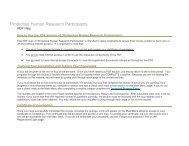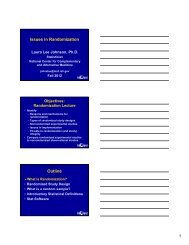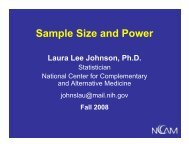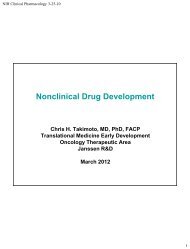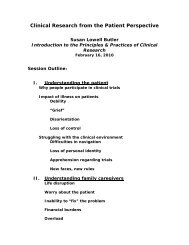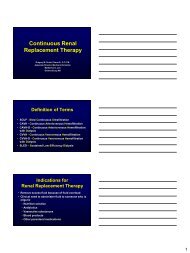Design of Case Report Forms
Design of Case Report Forms
Design of Case Report Forms
Create successful ePaper yourself
Turn your PDF publications into a flip-book with our unique Google optimized e-Paper software.
<strong>Design</strong> <strong>of</strong> <strong>Case</strong> <strong>Report</strong><br />
<strong>Forms</strong><br />
David W. Mailhot<br />
February 23, 2010<br />
<strong>Case</strong> <strong>Report</strong> Form<br />
• ..CRF<br />
Official clinical data-recording document or<br />
tool used in a clinical study<br />
PAPER<br />
RDC/RDE (Remote Data Capture,<br />
Remote Data Entry)<br />
Purpose<br />
Collects relevant data in a specific format<br />
• in accordance with the protocol<br />
• compliance with regulatory requirements<br />
Allows for efficient and complete data<br />
processing, analysis and reporting<br />
Facilitates the exchange <strong>of</strong> data across<br />
projects and organizations especially through<br />
standardization
CRF Relationship to<br />
Protocol<br />
Protocol determines what data should be<br />
collected on the CRF<br />
All data must be collected on the CRF if<br />
specified in the protocol<br />
Data that will not be analyzed should not<br />
appear on the CRF<br />
Protocol<br />
Analysis<br />
Plan<br />
Describes Study Conduct<br />
•purpose<br />
•objectives<br />
•operational aspects<br />
Describes Analysis<br />
•data presentations<br />
•key endpoints<br />
•statistical methods<br />
<strong>Case</strong><br />
<strong>Report</strong><br />
Form<br />
Collects data to support<br />
the above<br />
CRF Development<br />
• Guidelines<br />
Collect data outlined in the protocol<br />
Collect data to support the analysis plan<br />
Collect data required by the regulatory<br />
agencies
CRF Development<br />
• Guidelines (con’t)<br />
Collect data with all users in mind<br />
Be clear and concise with your data questions<br />
Avoid duplication<br />
Request minimal free text responses<br />
Provide units to ensure comparable values<br />
Provide instructions to reduce<br />
misinterpretations<br />
CRF Development<br />
• Guidelines (con’t)<br />
Provide “choices” for questions where possible<br />
Use <strong>of</strong> “None” and “Not done” for assesments<br />
Collect data in a fashion that allows for the<br />
most efficient computerization<br />
Collect data and formats that provides for<br />
pooling across studies<br />
CRF book needs to be finalized and available<br />
before an investigator starts enrolling patients<br />
into a study<br />
Elements <strong>of</strong> the CRF<br />
• Three major parts:<br />
Header<br />
Safety related modules<br />
Efficacy related modules<br />
• Module block <strong>of</strong> specific questions<br />
• CRF module(s) make up a single CRF page<br />
• CRF Book series <strong>of</strong> CRF pages
Header Information<br />
• Key identifying Information<br />
• MUST HAVES<br />
Study Number<br />
Site/Center Number<br />
Subject identification number<br />
Creating Safety Modules<br />
• Ideally come from a standard library<br />
• Select modules appropriate for your study<br />
• Keep safety analysis requirements in mind<br />
• Safety Modules usually include<br />
• Demographic<br />
• Adverse Events<br />
• Vital Signs<br />
• Medical History/Physical Exam<br />
• Concomitant Medications<br />
• Patient Disposition/Status at end <strong>of</strong> study<br />
Efficacy Modules<br />
• <strong>Design</strong>ed for each therapeutic area based on the<br />
protocol<br />
• Primary and secondary efficacy<br />
endpoints/parameters<br />
• Health Outcomes Assessments/Questionnaires<br />
• Considered to be “unique” modules and can be<br />
more difficult to develop<br />
• Use existing examples from similar protocols<br />
where applicable
Creating Efficacy Modules<br />
• Follow general CRF design guidelines<br />
• Include appropriate baseline measurements<br />
• Repeat same battery <strong>of</strong> tests<br />
• Define and identify<br />
• key efficacy endpoints<br />
• diagnostic tests for efficacy<br />
Importance <strong>of</strong> Standard<br />
CRFs<br />
• Prepares the way for data exchange<br />
• Removes the need for mapping during data<br />
exchange<br />
• Allows for consistent reporting across protocols,<br />
across projects<br />
• Promotes monitoring and investigator staff<br />
efficiency<br />
• Allows merging <strong>of</strong> data between studies<br />
• Provides increased efficiency in processing and<br />
analysis <strong>of</strong> clinical data<br />
CRF Development<br />
Process<br />
•Drafts CRF from protocol<br />
CRF <strong>Design</strong>er<br />
• CRF Review Meeting<br />
• Comments back to designer<br />
Reviewers<br />
CRF <strong>Design</strong>er<br />
• Updates CRF to include comments<br />
• Review and Sign <strong>of</strong>f/approval<br />
CRF Book<br />
• Coordinate printing and distribution<br />
Site
CRF Development Process<br />
• Responsibility for CRF design can vary between<br />
clinical research organizations (CRA, data<br />
manager, specialty role)<br />
• Interdisciplinary review is necessary<br />
• Each organization has its own process for<br />
review/sign-<strong>of</strong>f<br />
• Should include relevant members <strong>of</strong> the<br />
project team involved in conduct, analysis<br />
and reporting <strong>of</strong> the trial<br />
• Begins<br />
• As soon as possible in the study planning<br />
process (draft protocol)<br />
CRF Development Process<br />
• Review Team (example)<br />
• Clinician<br />
• CRA<br />
• Statistician<br />
• Programmer<br />
• Data Manager<br />
• Others<br />
• Database Development, Dictionary Coding,<br />
Standards<br />
CRF Development Process<br />
• After the CRF book is approved<br />
Initiate the process for printing<br />
Note: the Protocol must be approved before the<br />
CRF book is approved and printed<br />
• After it is printed<br />
Stored according to organizational guidelines<br />
Printed and distributed to research sites
Properly <strong>Design</strong>ed CRF<br />
• Components/All <strong>of</strong> the CRF pages are<br />
reusable in future studies<br />
• Saves time<br />
• Saves money<br />
+<br />
Poorly <strong>Design</strong>ed CRF<br />
• Necessary data not collected<br />
• Database may require modification<br />
• Data Entry process impeded<br />
• Need to review/clean data increases<br />
• Target dates are missed<br />
• Collected too much data – Wasted resources in<br />
collection and processing<br />
• Delay in getting study results and ability to<br />
adequately test the protocol objectives<br />
The <strong>Case</strong> <strong>Report</strong> Form<br />
• How do we use it?<br />
• Collect data from the investigational sites<br />
• Helps project team and study site team<br />
• Reminder to investigator to perform<br />
specific evaluations<br />
• CRA uses to verify protocol is being<br />
followed and compare with source<br />
documents<br />
• Statistics and Programming groups use it<br />
to build database structures, develop edit<br />
checks and programming specs
The <strong>Case</strong> <strong>Report</strong> Form<br />
• ...Data is Used for<br />
• Data analysis and reporting<br />
• Subject tracking<br />
• <strong>Report</strong>s to FDA on subject safety<br />
• Promotional materials<br />
• New Drug Application submissions<br />
• Support <strong>of</strong> labeling claims<br />
• Publication in medical journals<br />
Electronic CRFs<br />
• The use <strong>of</strong> RDC is increasing<br />
• In general, the concepts for the design <strong>of</strong><br />
electronic CRFs/RDC screens are the same as for<br />
paper CRFs<br />
• Electronic CRFs will impact the following:<br />
Review <strong>of</strong> CRF is different (screen review)<br />
No need to print and distribute paper<br />
Responsibility for Data entry<br />
Data quality checks at source<br />
Electronic CRFs and Data Capture<br />
• Types <strong>of</strong> Systems<br />
Direct entry into active database<br />
Entry into local disc/holding file for later<br />
loading/transfer<br />
Entry with second review necessary in<br />
order to change “status”
CRF Completion Guidelines<br />
• Used to give both general and specific guidance to<br />
facilitate quality data collection<br />
• Partial Dates<br />
• Unknowns<br />
• Missed Visits<br />
• Unplanned visits<br />
• Discontinued Subjects<br />
• May also include navigation or technical<br />
instructions associated with an EDC system<br />
Examples
Questions ?



